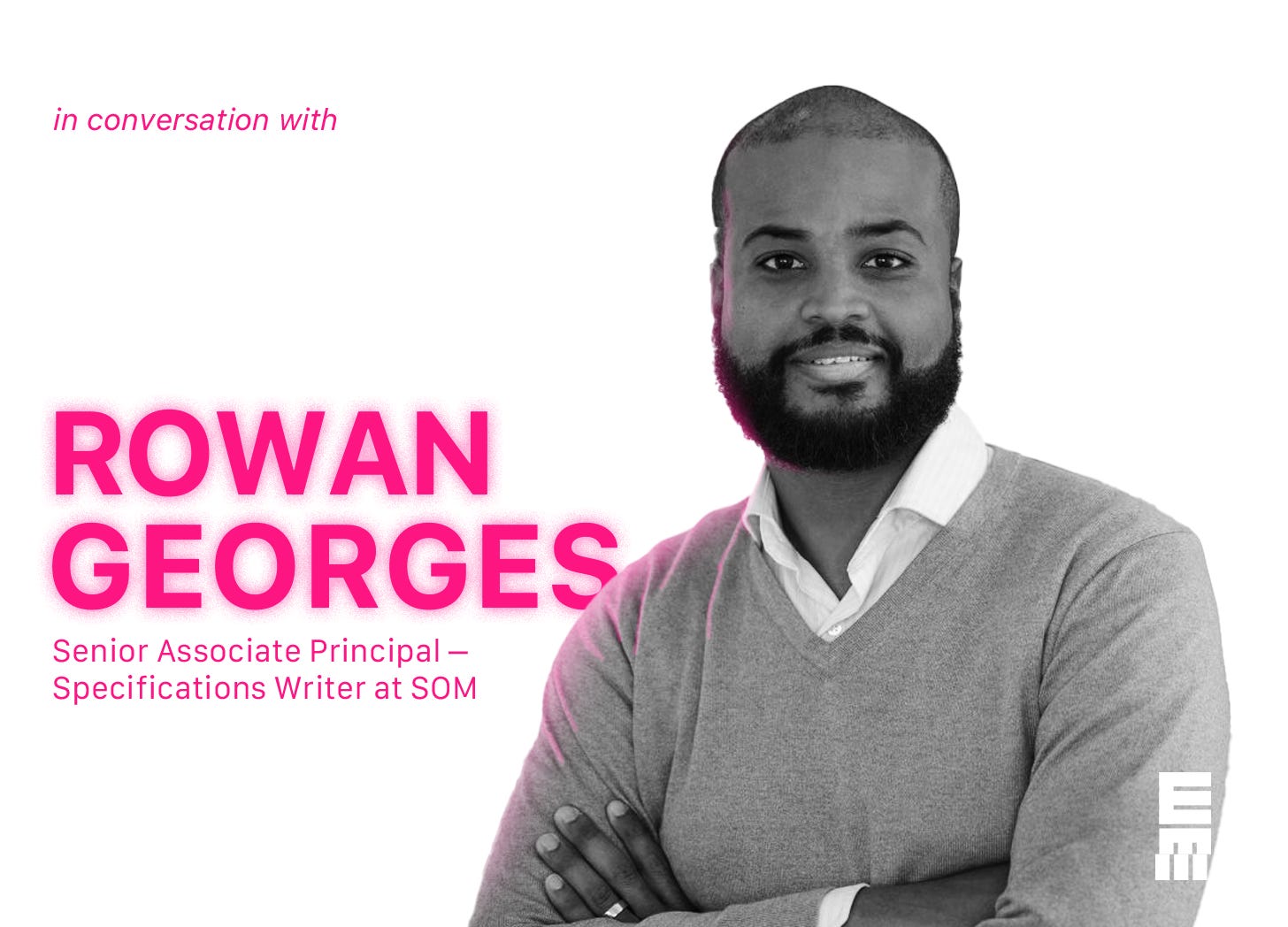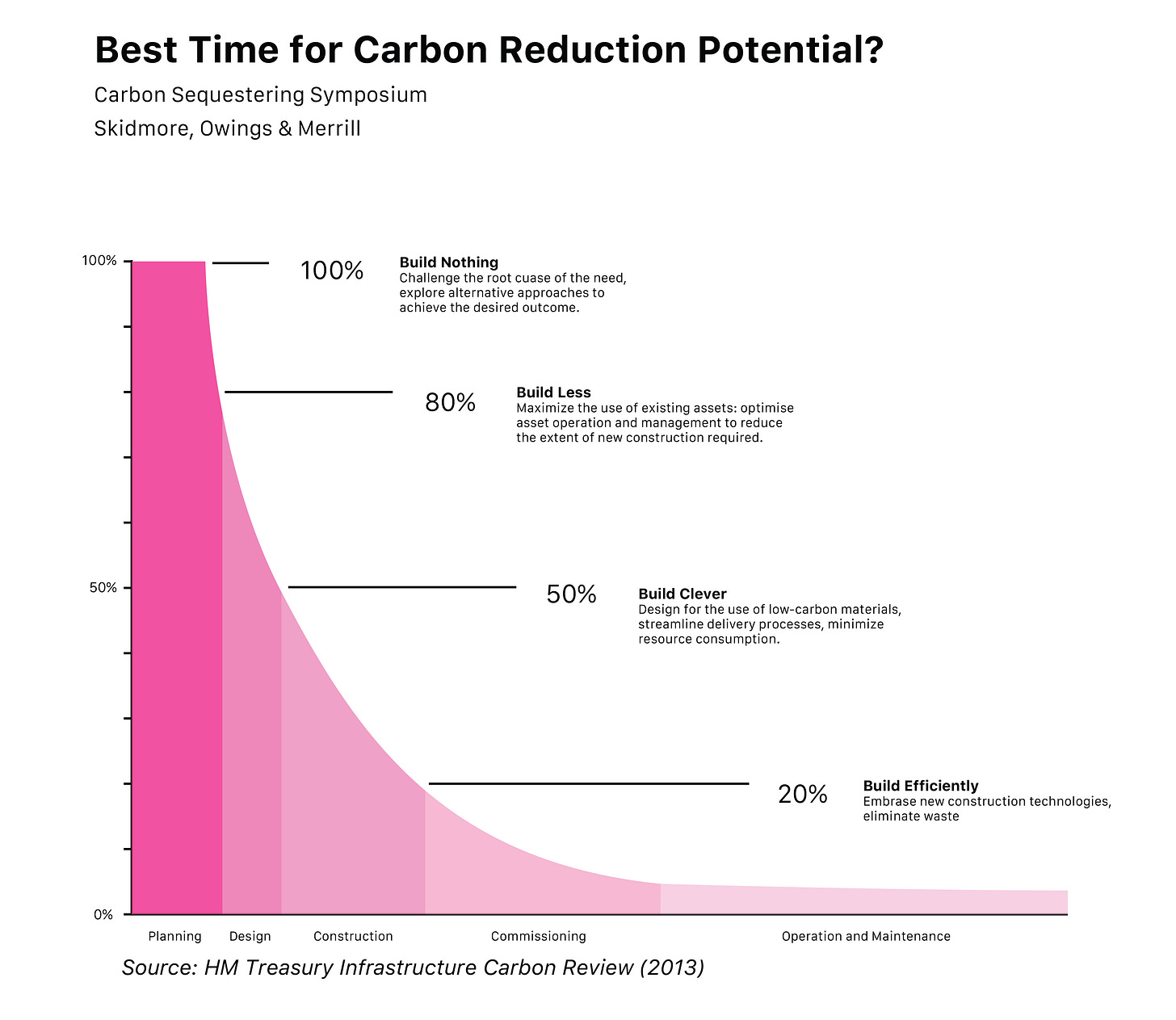The Brief
Over the last three years, Skidmore Owings & Merrill’s “D-Spec” initiative has sought to de-carbonize and de-chemicalize the master specifications of the global firm. Rowan Georges, a Senior Associate Principal at SOM, has been a leader in this effort - setting strict project requirements that go above and beyond environmental certifications. D-Spec has shifted not only the materials SOM specifies, but the way they design - prioritizing conversations about embodied energy, material sourcing, and product declarations as early as possible. Rowan’s efforts are taking shape as SOM’s first D-Spec buildings begin to open. Spec writers are some of the most ecologically impactful people in our industry. This is a responsibility that Rowan is not taking lightly.
The Unpack
This past week, I sat down with Rowan Georges, AIA to talk about his research at SOM. I first met Rowan this past fall at the NY Passive House symposium, where he was presenting SOM’s effort to de-carbonize and de-chemicalize their entire master specification - a project titled “D-Spec.” Rowan has been with SOM since 2005 and is currently a Senior Associate Principal specializing in specifications writing. He has worked on projects large and small and is now using his expertise to help elevate all SOM buildings to a healthier standard.
My first question for Rowan was, “what is a spec writer?” He described the role as the last line of defense for upholding the standards of the firm, code, environmental certifications, and industry. Every project goes through their team. They apply their vast knowledge of materials and products to create a complete construction documents set. Spec writers are responsible for maintaining the design intent while juggling material properties, installations, coordinations, budgets, and (now) carbon.
While I wasn’t too familiar with specification writing before I met Rowan, I soon learned that they shape our world far more than I imagined. Specification writers are the directors of huge amounts of matter and energy, especially at the scale of SOM projects. This is why Rowan, and the rest of the D-Spec team’s work is so important to shaping the future of built environment.
Architect Kiel Moe on one of his former architecture graduate students who works for AECOM as a sand spec writer:
“...by that job alone, she will have more of an impact socially, politically, ecologically…than any of us put together with all our little building projects.”
D-Spec took nearly three years to complete. Rowan was a leader in the global effort to reevaluate every material in SOM’s library. Each product and every material selection needed to address the carbon crisis at a minimum. They began by identifying the existing standards and certifications that govern carbon transparency (i.e. Environmental Product Declarations and Health Product Declarations). Next, they used environmental product databases (like FSC, mindful materials, and SPOT) to find comparable product substitutions, and then they started updating.
The low-hanging fruit was mandating EPDs and HPDs for as many specs as possible. The team even pushed manufacturers to make declarations so their products could be specified in SOM buildings. Some industries were more ahead of the curve than others - any products dependent on oil, like waterproofing and roofing, were generally slower to change.
“We needed to make sure that everything [SOM] puts out as construction documents will, at a minimum, address the carbon crisis.”
These declarations were paired with a Global Warming Potential (GWP) value and displayed on every specification. The environmental and health impact became a visible metric for anyone to reference.
This initiative did more than change SOM’s spec set, it changed their design process. The de-carbonized research had to be brought to the front of projects, and woven into the earliest design meetings to maximize its impact. D-Spec asked designers to reconsider how they were designing alongside what they were designing.
Rowan would ask designers how the material palette could be simplified, offer biomaterials as substitutes, and question how the design could be optimized to reduce complexity. If they needed to design with stone, they would collaborate on reducing the thicknesses, minimizing finishing, using low VOC fillers, and specifying regional quarries. Crucially, they would communicate standard material dimensions, so waste could be minimized wherever possible. This is the advantage of having all of these disciplines under one roof.
SOM’s first project to use D-Spec was the San Mateo County Office Building 3 in California. When it wraps this year it will be the first net-zero-energy mass timber civic building in the U.S. The combination of specification, engineering, and design input led to an 85% reduction in structural embodied carbon. Prefabricating the timber and simplifying the structural connections reduced construction time and waste. The team also leveraged timber’s material properties to eliminate non-renewable products like conventional hung acoustic ceilings.
As team members pushed each other internally to find the best ecological solutions, they also were pushing the industry. SOM was setting its own standards for project compliance regardless of any third-party environmental certification. LEED became the baseline.
Rowan described some of the pushback he has experienced for making ecological choices beyond LEED. He has held firm that these strict specifications are now project requirements - expressing the responsibility we all should feel to do our part in making every aspect of our buildings as healthy as possible. Acting on the question, “what can we do better?” is at the core of D-Spec and Rowan’s efforts. It is an initiative that SOM is putting its global brand behind.
Rowan hopes that projects like D-Spec will become the norm, and that interdisciplinary conversations will start happening earlier. Hopefully, other firms, large and small, will follow suit and make their own decarbonized and de-chemicalized project requirements. Rowan emphasized that as designers, spec writers, managers, builders, inhabitants, and manufactures, “we are all in this together.”
See above quote from Kiel Moe to reinforce just how important spec writers are to energy in architecture. Their impact is immense though too often understated. The spec writing community is in need of younger minds to bring their passion for decarbonized design to this influential field.
Check out more of SOM’s climate initiatives here, and ask yourself if spec writing is a possible career path for you. It is a creative and technical role that shapes the ecology of the entire planet. Experts like Rowan are leveraging that position to push our industry to change at an incredible scale.
What I’m Watching
This week I revisited Rowan’s talk at the 2022 NY Passive House symposium. I encourage anyone interested in learning more on SOM’s efforts to give it a watch.
What I’m Listening To
“What does our perception of time have to do with climate change? A lot.” from NPR’s Short Wave Podcast.
The description: The way we perceive time is affecting how we are addressing climate change. NPR investigated how our propensity to prioritize the present can be leveraged to tackle climate challenges.
See you next Friday,
Tom






